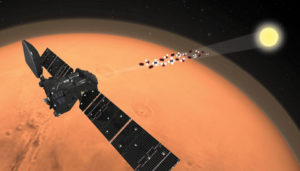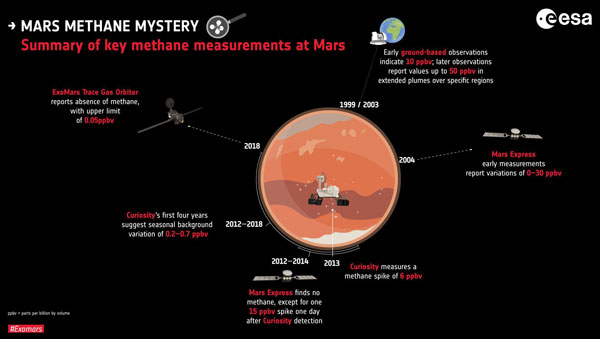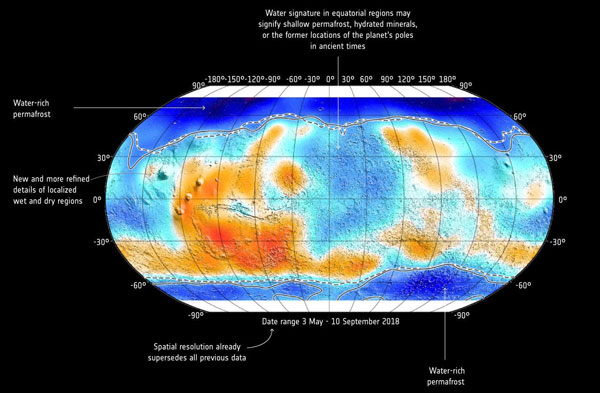The most advanced instrument ever sent to Mars to study its atmosphere has failed to find any methane after months of searching.

ESA / ATG medialab
The Exomars Trace Gas Orbiter (TGO), a spacecraft designed to measure vanishingly small amounts of gases in the Martian atmosphere, has failed to find any methane during the first months of its science operations.
The finding is particularly puzzling following the detection of the gas in several other studies of the Martian atmosphere. NASA’s Curiosity rover, the European Space Agency’s (ESA) Mars Express orbiter, and several ground-based telescopes have measured varying quantities of methane over the past 15 years. Curiosity has even found the gas cycles, varying from 0.2 to 0.7 parts per billion by volume (ppbv) with the seasons. In 2013 the rover discovered a spike in methane concentration that reached 5.78 ppbv, confirmed from orbit by the Planetary Fourier Spectrometer (PFS) onboard Mars Express.
TGO’s non-detection conflicts with these previous measurements. The orbiter, a collaborative project between the ESA and Roscosmos, the Russian space agency, is designed to look for trace quantities of gases within the carbon dioxide-dominated atmosphere. The spacecraft is equipped with two sensitive and independently operating spectrometers, the European NOMAD and the Russian ACS . Both instruments use the solar occultation method: they look at the way the Martian atmosphere absorbs sunlight to reveal chemicals in the air. The observations are essentially made at sunset from orbit, so that sunlight travels through as much atmospheric volume as possible.
TGO’s instruments are 100 times more sensitive than the PFS instrument onboard Mars Express. If any methane lurks in the atmosphere, it must be at a level below 0.05 ppbv, the limit of what TGO’s instruments can detect. (Under ideal conditions, TGO’s instruments may detect even lower amounts of methane.) That means less than 500 tons of methane exist within the whole planet’s atmosphere. Researchers expect they’ll be able to limit the presence of methane even further as spacecraft operations continue. The principal investigators of ACS and NOMAD reported these results on April 10th at the European Geosciences Union General Assembly in Vienna, Austria, and in the April 11th Nature.

ESA
Oleg Korablev (Russian Academy of Sciences), principal investigator of the ACS instrument, said that there’s still a possibility that the instrument could detect methane over the course of the mission. But, he adds, right now it’s difficult to reconcile their current measurements with the spikes of methane emission reported by other missions. “We just report our data,” Korablev said. “We leave it to theoreticians to try to explain them.”
TGO’s data are pushing researchers to make sense of these contradictory measurements. “Non-detections of methane on Mars are what we expect to be the rule, not the exception,” says Marco Giuranna (National Institute of Astrophysics, Italy), the principal investigator of the Mars Express PFS instrument. Giuranna and other researchers think methane might not always be present in the Martian atmosphere. For example, marsquakes or meteorite impacts might release methane trapped in underground reservoirs. “The presence of methane on Mars is likely characterized by small, short emissions and transient events [spikes], rather than by large emissions and a global presence,” Giuranna says.
Even so, it’s still difficult to explain what happens to the methane after it’s released. Current models suggest that methane should survive in the Martian atmosphere for at least 300 years before it disintegrates under ultraviolet radiation from the Sun. Simulations created by Giuranna and colleagues suggest that the methane Mars Express measured in 2013 would have increased global levels to 0.1 ppbv, uniformly distributed over the planet by winds. But if that were the case, most of it should still be in the atmosphere, and TGO should have detected it.
Another possible explanation is that some unknown mechanism removes methane from the atmosphere quickly and at low altitude. Researchers have estimated that the background levels that Curiosity has detected would reach levels measurable by TGO in only 20 years. “It’s very unlikely that Curiosity sits on the only source of methane on Mars,” Korablev says. Moreover, any removal mechanism must affect only methane, as existing models reproduce other components of the Martian atmosphere just fine.
A key difference between the measurements made by TGO, Curiosity, and Mars Express is where they are looking and when. While Curiosity samples the air 1 meter above ground, TGO struggles to see below 4 km in altitude, making the measurements difficult to compare directly. Chris Webster (Jet Propulsion Laboratory), principal investigator of the Tunable Laser Spectrometer onboard the Curiosity Rover, explains that atmospheric mechanisms could trap methane near the surface at night, while in the daytime it might diffuse up to higher altitudes. “The very lowest part of the Martian atmosphere may be a special place for methane containment,” Webster adds.
“We need to be more patient with TGO,” Webster says. “One thing we have learned is that the methane story is full of surprises, and there are surely more to come. It would not surprise me if TGO detected methane sometime in the future.”
A Better Mars Map of Shallow Subsurface Water
As the methane debate gathers most of the attention, researchers have also released an improved map of subsurface water on Mars.

ESA; spacecraft: ATG / medialab; data: I. Mitrofanov et al. (2018)
Water still exists on the Red Planet as water-ice and bound to hydrated minerals. Using another instrument onboard TGO, the Fine-Resolution Epithermal Neutron Detector (FREND), researchers have created a map of hydrogen within the first meter or so of the Martian surface. Since hydrogen atoms are part of water, they serve as a proxy for the presence of water, whether it’s absorbed into the surface or trapped in minerals that formed in the presence of water.
In its first 131 days of observing, the instrument has already produced a map with a higher resolution than its predecessor, the High Energy Neutron Detector (HEND) onboard NASA’s Mars Odyssey. The new map reveals concentrations of water up to 12% in volume near the polar regions, as well as water rich areas in equatorial regions. It also revealed a previously unseen water-rich region inside the deep Valles Marineris canyon.
 0
0









Comments
You must be logged in to post a comment.